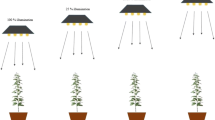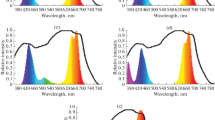Abstract
In urban agriculture, plant growth is limited by the availability of light. Light emitting diodes (LED) could provide specific quality and quantity of light overcoming existing limitations for normal plant growth. However, there have been very few investigations on the applications of LED in incubators and plant growth chambers. The devices fabricated in this study, were lighted with 100 % red, 100 % blue, 70 % red plus 30 % blue, or 100 % white LED. We cultivated Mentha piperita, Mentha spicata and Mentha longifolia, lentil, basil, and four ornamentals to test the effect of various LED lights on plants productivity compared with field and greenhouse conditions. Our results show that 70/30 % red-blue LED light increased Mentha essential oil yield up to four times along with increases in plant photosynthesis and fresh weight compared with field condition. The red-blue LED incubator also led to a better growth of lentil and basil and to higher flower buds and less days to flowering for pot flowers versus greenhouse conditions. Our findings demonstrate that LED could improve economic characteristics of plant species by probably stimulating plant metabolism.



Similar content being viewed by others
References
Banerjee R, Batschauer A (2005) Plant blue-light receptors. Planta 20:498–502. doi:10.1007/s00425- 004-1418-z
Boss PK, Bastow RM, Mylne JS, Dean C (2004) Multiple pathways in the decision to flower: enabling, promoting, and resetting. Plant Cell 16:S18–S31. doi:10.1105/tpc.015958
British Pharmacopoeia, (1980) H. M. S. Office. 2, London, pp 109–110
Brown CS, Schuerger AC, Sager JC (1995) Growth and photomorphogenesis of pepper plants under red light-emitting diodes with supplemental blue or far-red lighting. J Am Soc Hortic Sci 120:808–813
Colquhoun TA, Schwieterman ML, Gilbert JL, Jaworski EA, Langer KM, Jones CR, Rushing GV, Hunter TM, Olmstead J, Clark D, Folta KM (2013) Light modulation of volatile organic compounds from petunia flowers and select fruits. Postharvest Biol Technol 86:37–44. doi:10.1016/j.postharvbio.2013.06.013
Darko E, Heydarizadeh P, Schoefs B, Sabzalian MR (2014) Photosynthesis under artificial light: the shift in primary and secondary metabolism. Phil Trans R Soc B 20130243. doi:10.1098/rstb.2013.0243
Delepoulle S, Renaud C, Chelle M (2008) Improving light position in a growth chamber through the use of a genetic algorithm. In: Plemenos D, Miaoulis G (eds), Artificial Intelligence Techniques for Computer Graphics Studies in Computational Intelligence, Springer, Berlin, Heidelberg, pp. 67-82
Duong TN, Hong LTA, Watanabe H, Goi M, Tanaka M (2002) Growth of banana plantlets cultured in vitro under red and blue light-emitting diode (LED) irradiation source. Acta Horticult 575:117–124
Folta KM, Koss LL, McMorrow R, Kim H-H, Kenitz JD, Wheeler R, Sager JC (2005) Design and fabrication of adjustable red-green-blue LED light arrays for plant research. BMC Plant Biol. 5:17. doi: 10.1186/1471-2229-5-17
Goins GD, Yorio NC, Sanwo MM, Brown CS (1997) Photomorphogenesis, photosynthesis, and seed yield of wheat plants grown under red light-emitting diodes (LEDs) with and without supplemental blue lighting. J Exp Bot 48:1407–1413
Heo JW, Lee CW, Murthy HN, Paek KY (2003) Influence of light quality and photoperiod on flowering of Cyclamen persicum Mill. cv. ‘Dixie White’. Plant Growth Regul 40:7–10. doi:10.1023/a:1023096909497
Heydarizadeh P, Zahedi M, Sabzalian MR, Ataii E (2013) Mycorrhizal infection, essential oil content and morpho-phenological characteristics variability in three mint species. Sci Hortic 153:136–142. doi:10.1016/j.scienta.2013.01.014
Katsuda T, Shimahara K, Shiraishi H, Yamagami K, Ranjbar R, Katoh S (2006) Effect of flashing light from blue light emitting diodes on cell growth and astaxanthin production of Haematococcus pluvialis. J Biosci Bioeng 102:442–446. doi:10.1263/jbb.102.442
Kurilcik A, Miklusyte-Canova R, Dapkuniene S, Zilinskaite S, Kurilcik G, Tamulaitis G, Duchovskisand P, Zukauskas A (2008) In vitro culture of Chrysanthemum plantlets using light-emitting diodes. Cent Eur J Biol 2:161–167. doi:10.2478/s11535-008-0006-9
Lian M-L, Murthy HN, Paek K-Y (2002) Effects of light emitting diodes (LEDs) on the in vitro induction and growth of bulblets of Lilium oriental hybrid ‘Pesaro’. Sci Hortic 94:365–370. doi:10.1016/S0304-4238(01)00385-5
Lin C (2000) Plant blue-light receptors. Trends Plant Sci 5:337–342
Liu Y, Roof S, Ye Z, Barry C, van Tuinen A, Vrebalov J (2004) Manipulation of light signal transduction as a means of modifying fruit nutritional quality in tomato. PNAS 101:9897–9902. doi:10.1073/pnas.0400935101
Martineau V, Lefsrud M, Tahera Nazanin M, Kopsell DA (2012) Comparison of light-emitting diode and high-pressure sodium light treatments for hydroponics growth of Boston lettuce. Hortscience 47:477–482
Nhut DT, Takamura NT, Watanabe H, Tanaka M (2000) Light emitting diodes (LEDs) as a radiation source for micropropagation of strawberry. In: Kubota C, Chun C (eds.), Transplant production in the 21st century, Kluwer Academic Publishers, Dordrecht, The Netherlands, pp 114–118
Okamoto K, Yanagi T, Kondo S (1997) Growth and morphogenesis of lettuce seedlings raised under different combinations of red and blue light. Acta Horticult 435:149–157
Poudel PR, Kataoka I, Mochioka R (2008) Effect of red- and blue-light-emitting diodes on growth and morphogenesis of grapes. Plant Cell Tissue Organ Cult 92:147–153. doi:10.1007/s11240-007-9317-1
Roh MS, Lawson RH (1996) Requirements for new floral crops-perspectives for the United States of America. Acta Horticult 454:29–38
Runkle ES, Heins RD (2001) Specific functions of red, far red, and blue light in flowering and stem extension of long-day plants. J Am Soc Hortic Sci 126:275–282
SAS Institute, Inc (1999) SAS/STAT User’s Guide. SAS Institute, Inc, Cary
Schaer JA, Mandoli DF, Briggs WR (1983) Phytochrome-mediated cellular photomorphogenesis. Plant Physiol 72:706–712
Schoefs B (2002) Chlorophyll and carotenoid analysis in food products. Properties of the pigments and methods of analysis. Trends Food Sci Technol 13:361–371. doi:10.1016/S0924- 2244(02)00182-6
Shimazaki K, Doi M, Assmann SM, Kinoshita T (2007) Light regulation of stomatal movement. Annu Rev Plant Biol 58:219–247. doi:10.1146/annurev.arplant.57.032905.105434
Singh AK (2006) Flower crops: cultivation and management. New India Publishing Agency, Pitampuram
Tamulaitis G, Duchovskis P, Bliznikas Z, Breive K, Ulinskaite R, Brazaityte A, Novickovas A, Zukauskas A (2005) High-power light-emitting diode based facility for plant cultivation. J Phys D Appl Phys 38:3182–3187. doi:10.1088/0022-3727/38/17/S20
Wang C-Y, Fub C-C, Liu Y-C (2007) Effects of using light-emitting diodes on the cultivation of Spirulina platensis. Biochem Eng J 37:21–25. doi:10.1016/j.bej.2007.03.004
Wu M-C, Hou C-Y, Jiang C-M, Wang Y-T, Wang C-Y, Chen H-H, Chang H-M (2007) Novel approach of LED light radiation improves the antioxidant activity of pea seedlings. Food Chem 101:1753–1758. doi:10.1016/j.foodchem.2006.02.010
Yam FK, Hassan Z (2005) Innovative advances in LED technology. Microelectron J 36:129–137. doi:10.1016/j.mejo.2004.11.008
Yamaoka Y, Carmona ML, Oota S (2004) Growth and carotenoid production of Thraustochytrium sp. CHN-1 cultured under super-bright red and blue light-emitting diodes. Biosci Biotechnol Biochem 68:1594–1597
Yanagi T, Okamoto K (1997) Utilization of super-bright light emitting diodes as an artificial light source for plant growth. Acta Horticult 418:223–228
Yeh N, Chung J-P (2009) High-brightness LEDs-energy efficient lighting sources and their potential in indoor plant cultivation. Renew Sustain Energ Rev 13:2175–2180. doi:10.1016/j.mejo.2004.11.008
Yorio NC, Goins GD, Kagie HR, Wheeler RM, Sager JC (2001) Improving spinach, radish, and lettuce growth under red light-emitting diodes (LEDs) with blue light supplementation. Hortscience 36:380–383
Acknowledgments
The corresponding author would like to thank the Iranian National Elites Foundation and Isfahan University of Technology for the financial support of this research. BS also thanks the University of Le Mans for support. We would also like to express our appreciation to Mr. Ehsan Ataii for the assistance in conducting experiments and Prof. Aghafakhr Mirlohi for the critical review of the preliminary draft of this manuscript.
Author information
Authors and Affiliations
Corresponding author
About this article
Cite this article
Sabzalian, M.R., Heydarizadeh, P., Zahedi, M. et al. High performance of vegetables, flowers, and medicinal plants in a red-blue LED incubator for indoor plant production. Agron. Sustain. Dev. 34, 879–886 (2014). https://doi.org/10.1007/s13593-014-0209-6
Accepted:
Published:
Issue Date:
DOI: https://doi.org/10.1007/s13593-014-0209-6




